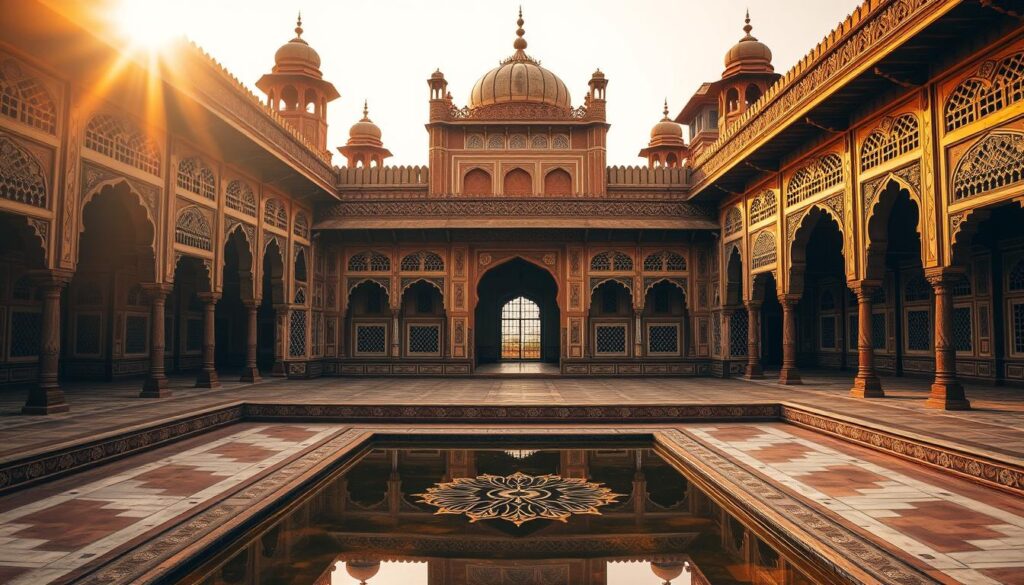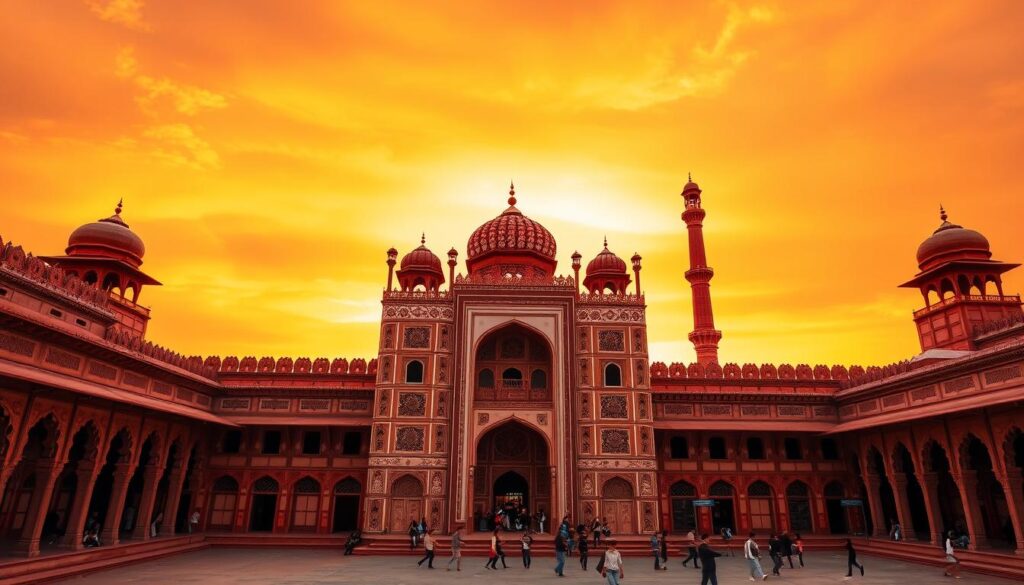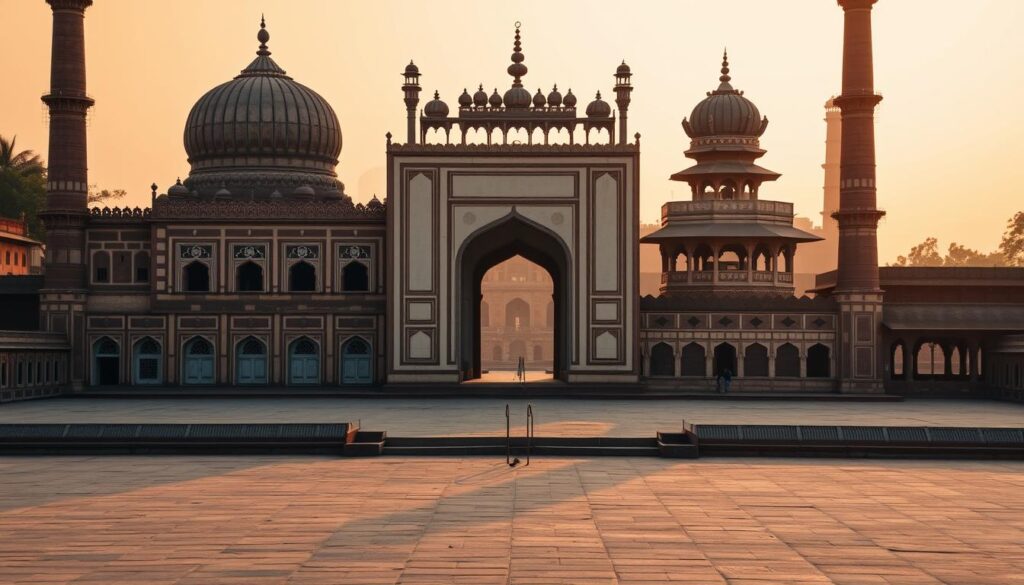How did Fatehpur Sikri’s architecture influence later Mughal buildings: Explore how Fatehpur Sikri’s iconic architecture influenced later Mughal buildings in India.
We explore Fatehpur Sikri, a city started by Emperor Akbar in 1571. It was the capital of the Mughal Empire. The city’s Mughal architecture mixed styles like Timurid, Gujarati, and local Indian traditions.

This mix of styles makes Fatehpur Sikri very interesting. It shows the architectural legacy of the Mughal Empire. Akbar’s dream for the city is seen in its design. This design greatly influenced later Mughal buildings.
Key Takeaways
- Fatehpur Sikri was founded by Emperor Akbar in 1571.
- The city’s architecture was influenced by multiple styles.
- Fatehpur Sikri’s design had a lasting impact on Mughal buildings.
- The city’s architectural legacy continues to be celebrated.
- Fatehpur Sikri is a significant example of Mughal architecture.
The Architectural Marvel of Fatehpur Sikri
Exploring Fatehpur Sikri reveals its rich history and architectural brilliance. Built during Akbar’s reign, it showcases a unique blend of cultural influences. This blend shaped its architecture.

Historical Context and Akbar’s Vision
Fatehpur Sikri was built on a rocky ridge. It was surrounded by a wall on three sides and a lake on the fourth. Akbar wanted to create a capital that showed the Mughal dynasty’s skill in architecture.
Related Posts: Our Guide to Fatehpur Sikri Timings in India
Distinctive Indo-Islamic Features
The city’s architecture combines Hindu and Muslim styles. This reflects the cultural diversity of the region. Indo-Islamic features include arches, domes, and intricate carvings.
Innovative Construction Techniques
The construction of Fatehpur Sikri used new techniques. Red sandstone and marble were used in its buildings. The designs were monumental, showing the grandeur of the Mughal Empire.
Fatehpur Sikri is a testament to the Mughal dynasty’s architectural innovation. It has influenced later Mughal buildings and left a lasting mark on Indian architecture.
How Did Fatehpur Sikri’s Architecture Influence Later Mughal Buildings?
Fatehpur Sikri’s architecture had a big impact on Mughal buildings. Its design and construction raised the bar for Mughal architecture. This influence can be seen in many later buildings.
Fusion of Persian, Indian, and Islamic Styles
Fatehpur Sikri’s buildings mixed Persian, Indian, and Islamic styles. This mix created a unique look that other Mughal buildings followed. Arches, domes, and detailed ornamentation became key features of Mughal architecture.

Red Sandstone and Marble Craftsmanship
The use of red sandstone and marble was a key feature of Fatehpur Sikri. The city’s buildings showed off amazing craftsmanship, like carvings and inlays. This focus on detail helped make Mughal buildings famous for their quality.
Spatial Organization and Courtyard Layouts
Fatehpur Sikri’s layout, with its courtyards and organized spaces, shaped later Mughal buildings. Its design, balancing public and private areas, was copied in other Mughal complexes. This shows how Fatehpur Sikri’s architecture influenced many buildings.
Notable Examples of Fatehpur Sikri’s Architectural Legacy
Fatehpur Sikri’s legacy is seen in many famous Mughal structures. Its innovative design and architectural elements have influenced many buildings. This shows how its architecture has shaped the Mughal style.
The Red Fort Complex in Delhi
The Red Fort Complex in Delhi is a clear example of Fatehpur Sikri’s impact. Its design and layout mirror Fatehpur Sikri’s red sandstone architecture and spatial planning.
Taj Mahal’s Design Elements
The Taj Mahal’s design was influenced by Fatehpur Sikri, just like its marble and intricate inlays. It also blends Indian and Islamic styles, similar to Fatehpur Sikri.
Akbar’s Tomb at Sikandra
Akbar’s Tomb at Sikandra shows Fatehpur Sikri’s influence. Its design and layout, with red sandstone and marble, are innovative.
Jama Masjid and Other Religious Structures
Jama Masjid and other Mughal religious structures reflect Fatehpur Sikri’s style. They have large courtyards and imposing gateways, like the Buland Darwaza.
These examples show Fatehpur Sikri’s lasting impact on Mughal architecture. Its historical influence is evident in many later Mughal buildings.
Conclusion: The Enduring Legacy of Fatehpur Sikri
Fatehpur Sikri’s impact on Mughal architecture is significant. It was a cultural and architectural center. Its buildings, blending styles, set a new standard.
The Mughal dynasty’s architectural achievements, inspired by Fatehpur Sikri, are celebrated. Reflecting on the city’s legacy, we see its role in shaping the region’s architecture. Its influence is still seen in many iconic structures, showing Fatehpur Sikri’s lasting impact.
FAQ
What is the significance of Fatehpur Sikri in Mughal architecture?
Fatehpur Sikri is a key example of Mughal architecture. It shows a mix of Indo-Islamic styles and new construction methods. These innovations influenced later Mughal buildings.
Who commissioned the construction of Fatehpur Sikri?
Akbar, the Mughal emperor, commissioned Fatehpur Sikri. He built the city as his capital from 1571 to 1585.
What architectural styles are reflected in Fatehpur Sikri’s design?
Fatehpur Sikri’s design combines Timurid, Gujarati, Hindu, and Muslim styles. It’s a unique blend of cultures and architecture.
How did Fatehpur Sikri’s architecture influence later Mughal buildings?
Fatehpur Sikri’s architecture, like the use of red sandstone and marble, was adopted in later Mughal buildings. This includes the Red Fort, Taj Mahal, and Akbar’s Tomb.
What are some notable examples of Mughal architecture influenced by Fatehpur Sikri?
The Red Fort Complex in Delhi, Taj Mahal, Akbar’s Tomb at Sikandra, and Jama Masjid show Fatehpur Sikri’s influence. They reflect its architectural legacy.
What is the significance of the Buland Darwaza in Fatehpur Sikri?
The Buland Darwaza is a famous structure in Fatehpur Sikri. It has influenced later Mughal architecture. It shows the city’s architectural innovations and grandeur.
How did Fatehpur Sikri’s construction techniques contribute to its architectural legacy?
Fatehpur Sikri’s use of red sandstone and marble in construction contributed to its legacy. These techniques influenced the development of Mughal architecture.

My name is Radha Sharma and I live in Agra. I have started this first blog of my life Agrafast.in to make my future in blogging by watching videos of many big bloggers through the internet for a long time.

